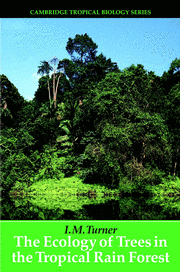4 - Reproductive biology
Published online by Cambridge University Press: 24 November 2009
Summary
Reproduction
The high species diversity of the tropical rain forest is inevitably associated with low population densities for a majority of species. Most tree species will exist at densities below ten mature individuals per hectare of forest, and many will live in much sparser populations. Tropical ecologists have long been intrigued by the possible ability of tropical tree populations of widely separated individuals to outbreed successfully. In recent years, new techniques for genetically fingerprinting individuals have provided strong evidence that many tropical tree species are strongly outbreeding despite large average distances between trees within a population.
Vegetative reproduction
There have been relatively few studies of vegetative reproduction in tropical trees. However, a number of reports refer to the marked ability of some understorey species to root from plant fragments including stems and leaves (Gartner 1989; Kinsman 1990; Sagers 1993). Shrubs, such as species of Psychotria and Piper, may need to be resilient to damage as they stand a relatively high chance of being broken by falling tree parts or large animals. An ability to re-sprout and produce adventitious roots will allow broken fragments to establish as new plants. Even the large-tree species, Tetramerista glabra, from the peat swamp forests of Borneo has been reported to employ this method of propagation (Gavin & Peart 1997, 1999). Many Tetramerista ‘seedlings’ are actually sprouts from fallen branches or collapsed saplings.
A wide range of tropical trees are typically multi-stemmed.
- Type
- Chapter
- Information
- The Ecology of Trees in the Tropical Rain Forest , pp. 122 - 179Publisher: Cambridge University PressPrint publication year: 2001

